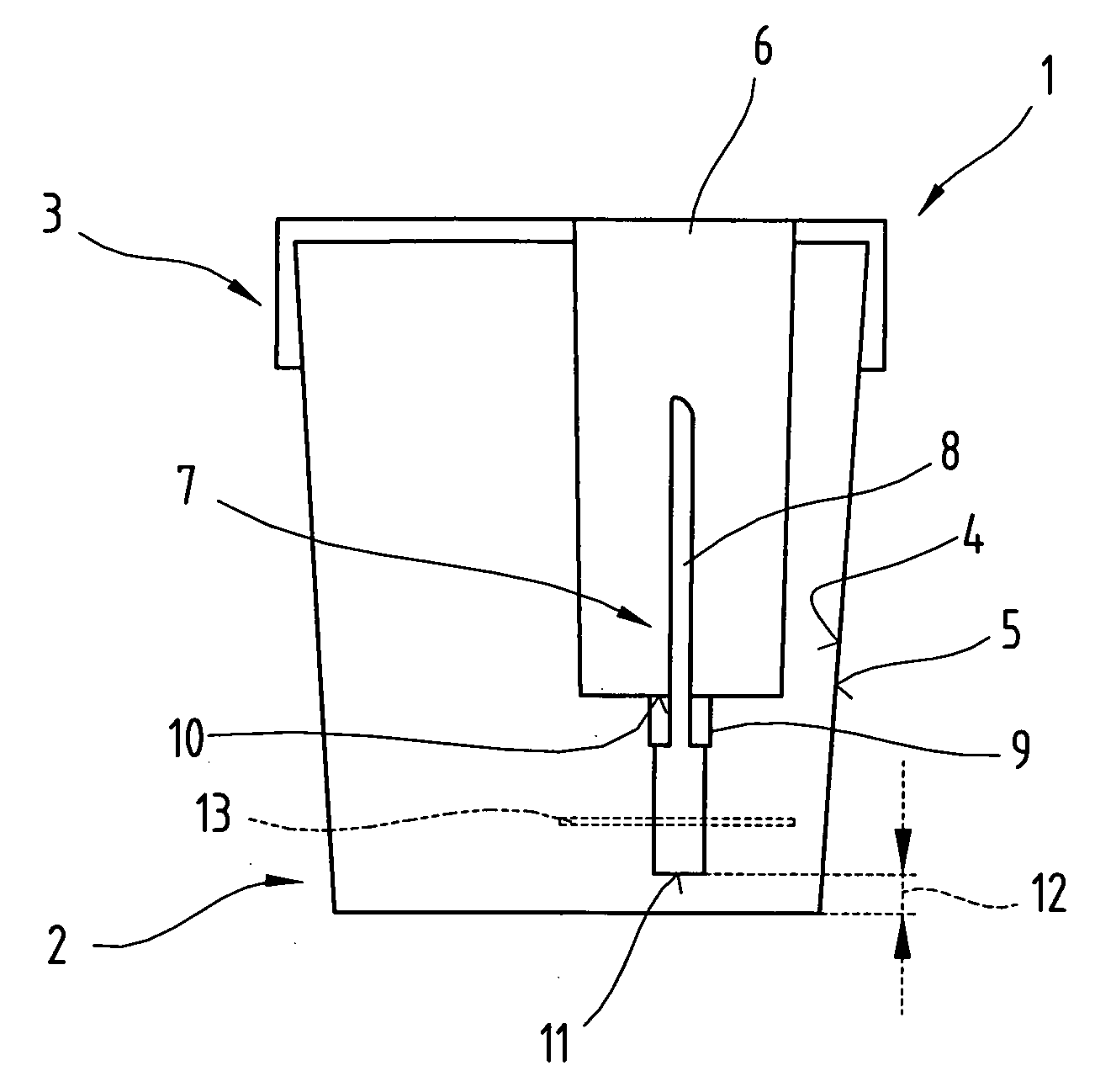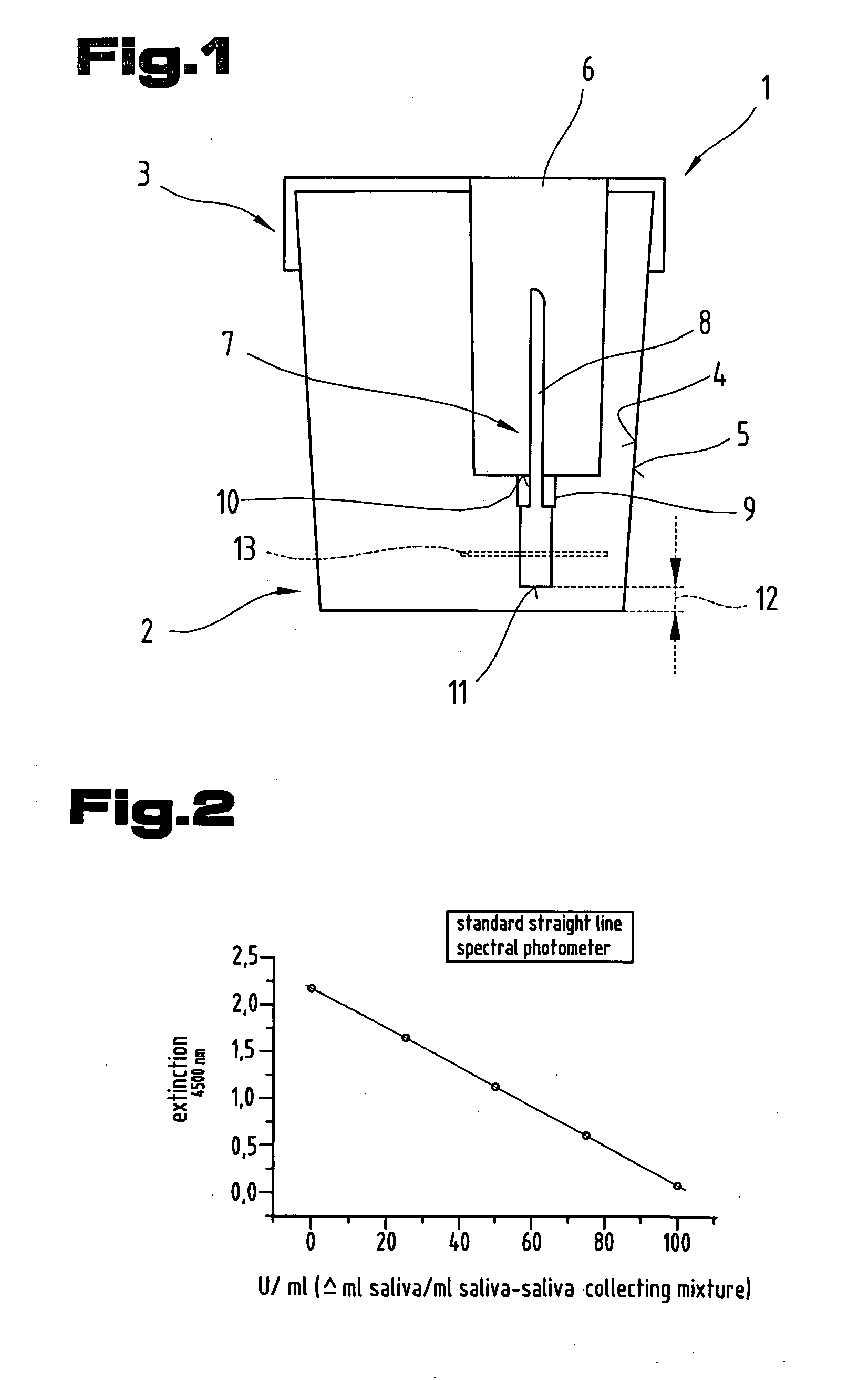In-vitro diagnostic medical devices for determining saliva volume
a medical device and saliva volume technology, applied in the field of saliva collection, can solve the problems of pain and stress, limited availability, and inability to meet the needs of qualified personnel, and achieve the effects of increasing the reproducibility and reliability of tests, reducing variability from subject to subject, and increasing saliva secretion
- Summary
- Abstract
- Description
- Claims
- Application Information
AI Technical Summary
Benefits of technology
Problems solved by technology
Method used
Image
Examples
embodiment 1
[0159]Before gargling 2 ml of saliva-collecting solution corresponding to the composition listed in the table, the patient rinses the mouth with distilled water in order to remove any food remains or other components which might lead to distortion from the oral cavity.
Saliva-Collecting Solution:
[0160]
Pilocarpin 6 mgYellow orange S200 mgCholesterine100 mgStrawberry flavouring 10 mgTop up with distilled water to a volume of 1000 mlAdjust to a pH value of 4.5
[0161]After gargling four times a minute, each time with 2 ml of saliva-collecting solution, all of the saliva-saliva collecting solution mixture in the container 1 is collected, the distance of the tubular projection 9 from the base of the base part 2 of the container 1 being 2 mm. A filtration unit 13 of glass wool is also disposed in the container 1, in the region of the tubular projection 9. The pore size of the filtration unit 13 is 50 μm.
[0162]The saliva-saliva collecting solution mixture is transferred to an evacuated collec...
embodiment 2
[0169]The patient gargles 6 ml of saliva-collecting solution based on the composition specified in the table.
Saliva-Collecting Solution:
[0170]
Ascorbic acid4 gCurcumin2 gTop up with distilled water to a volume of 1000 mlAdjust to a pH value of 5
[0171]After gargling the saliva-collecting solution for 5 minutes, the saliva-saliva collecting solution mixture is collected in the container 1, the distance of the tubular projection 9 from the base of the base part 2 of the container 1 being 0.9 mm. Also disposed in the container 1 in the region of the tubular projection 9 is a filtration unit 13 in the form of a nitrocellulose membrane between the penetration device 8 and the tubular projection 9. The pore size of the filtration unit 13 is 10 μm.
[0172]The saliva-saliva collecting solution mixture is transferred to an evacuated collection vessel, which is coated with the solution specified in the table.
Solution with Reagents:
Potassium benzoate 8 g / lSodium chloride15 g / l
[0173]The collection ...
embodiment 3
[0178]Before gargling 5 ml saliva-collecting solution based on the composition specified in the table, the patient rinses the mouth with distilled water in order to remove any food remains or other components which might cause distortion from the oral cavity.
Saliva-Collecting Solution:
[0179]
Sodium dihydrogen citrate20 g Sodium citrate tribasic monocitrate8 gGlucose5 gTop up with distilled water to a volume of 1000 mlAdjust pH value to 4.0
[0180]After gargling with the saliva-collecting solution for three minutes, the saliva-saliva collecting solution mixture is collected in the container 1, the distance of the tubular projection 9 from the base of the base part 2 of the container 1 being 3 millimetres.
[0181]The saliva-saliva collecting solution mixture is transferred to an evacuated collection vessel, which is coated with the solution specified in the table.
Solution with Reagents:
Potassium benzoate 1 g / lPotassium chloride0.05 g / l
[0182]The collection vessel with the saliva-saliva col...
PUM
| Property | Measurement | Unit |
|---|---|---|
| optical density | aaaaa | aaaaa |
| optical density | aaaaa | aaaaa |
| optical density | aaaaa | aaaaa |
Abstract
Description
Claims
Application Information
 Login to View More
Login to View More - R&D
- Intellectual Property
- Life Sciences
- Materials
- Tech Scout
- Unparalleled Data Quality
- Higher Quality Content
- 60% Fewer Hallucinations
Browse by: Latest US Patents, China's latest patents, Technical Efficacy Thesaurus, Application Domain, Technology Topic, Popular Technical Reports.
© 2025 PatSnap. All rights reserved.Legal|Privacy policy|Modern Slavery Act Transparency Statement|Sitemap|About US| Contact US: help@patsnap.com


